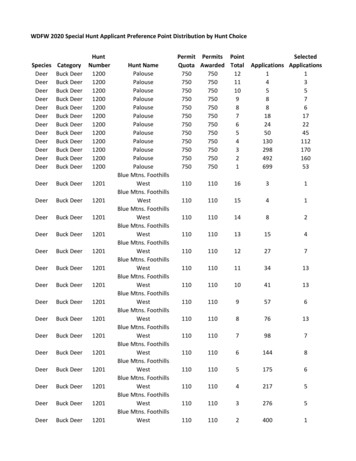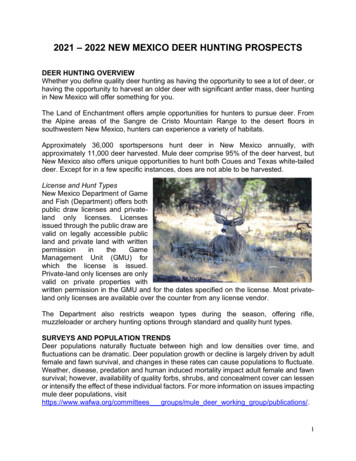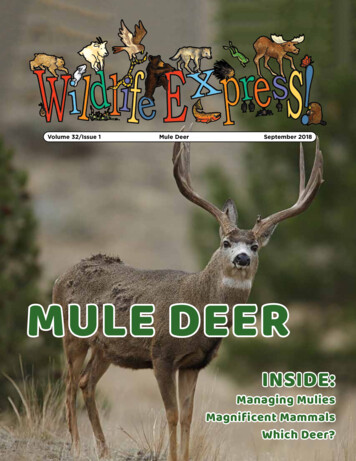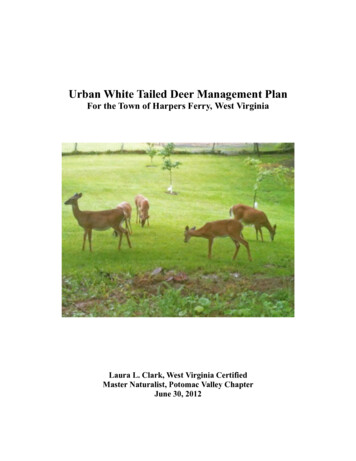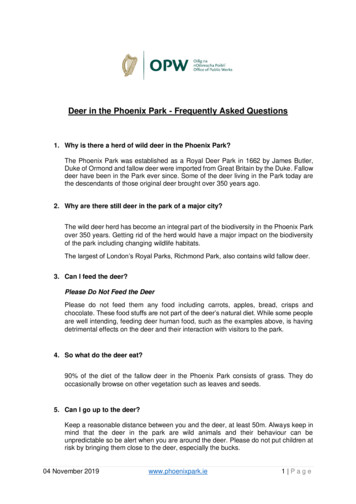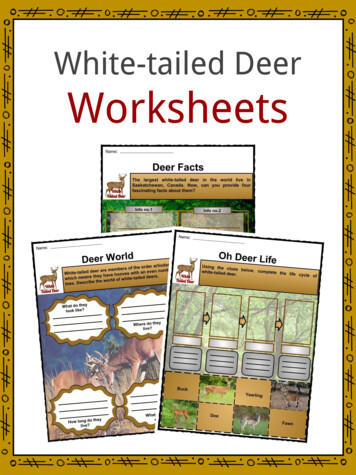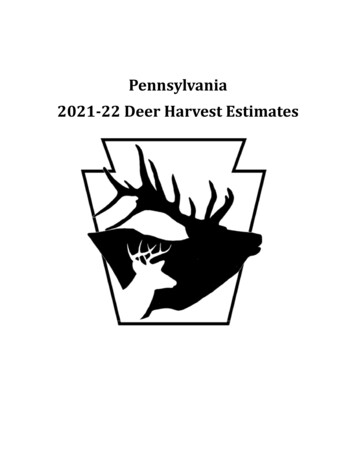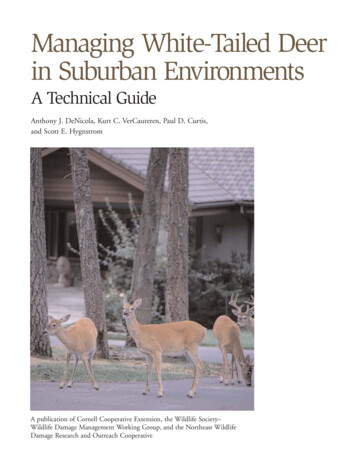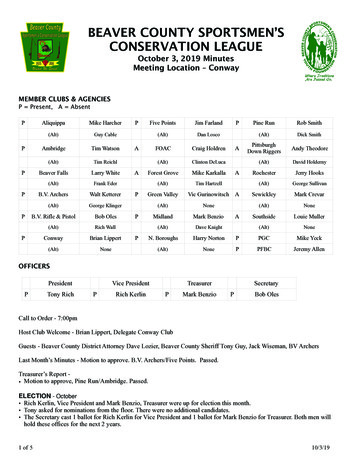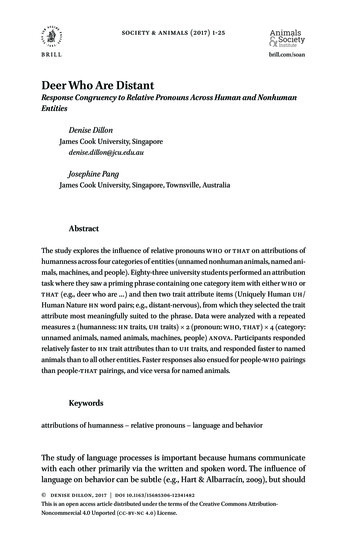
Transcription
society & animals (2017) 1-25brill.com/soanDeer Who Are DistantResponse Congruency to Relative Pronouns Across Human and NonhumanEntitiesDenise DillonJames Cook University, Singaporedenise.dillon@jcu.edu.auJosephine PangJames Cook University, Singapore, Townsville, AustraliaAbstractThe study explores the influence of relative pronouns who or that on attributions ofhumanness across four categories of entities (unnamed nonhuman animals, named animals, machines, and people). Eighty-three university students performed an attributiontask where they saw a priming phrase containing one category item with either who orthat (e.g., deer who are ) and then two trait attribute items (Uniquely Human UH/Human Nature HN word pairs; e.g., distant-nervous), from which they selected the traitattribute most meaningfully suited to the phrase. Data were analyzed with a repeatedmeasures 2 (humanness: HN traits, UH traits) 2 (pronoun: who, that) 4 (category:unnamed animals, named animals, machines, people) ANOVA. Participants respondedrelatively faster to HN trait attributes than to UH traits, and responded faster to namedanimals than to all other entities. Faster responses also ensued for people-who pairingsthan people-that pairings, and vice versa for named animals.Keywordsattributions of humanness – relative pronouns – language and behaviorThe study of language processes is important because humans communicatewith each other primarily via the written and spoken word. The influence oflanguage on behavior can be subtle (e.g., Hart & Albarracín, 2009), but should Denise dillon, 7 doi 10.1163/15685306-12341482This is an open access article distributed under the terms of the Creative Commons AttributionNoncommercial 4.0 Unported (CC-BY-NC 4.0) License.
2doi 10.1163/15685306-12341482 Dillon AND Pangnot be ignored. For example, language offers insight into people’s mentalhealth, and some therapies involving language are effective in improving mental health (Pennebaker, 2002). As for the specific choice of words we use forreferent categories, Brown (1958), an eminent psychologist in the area of childlanguage development, reminded us that “there is a sense in which lexicondetermines cognition and inferences about cognition can be based on lexicon”(p. 245). Put simply, we can get a sense of how people are thinking throughwhat they choose to say.Importantly also, cognitive psychology research has shown that, when facedwith a discrepancy between language and belief, people will change one or theother to reduce what is known as cognitive dissonance. In the context of animal advocacy, the choice to include nonhuman animals in the same category ofliving entities as humans is reflected in subtle language practices such as pronoun use (e.g., hens who suffer in egg factories) (Dunayer, 2001). Another suchpractice involves metaphors whereby nonhuman animal characteristics areused to infer derogatory evaluations of people (e.g., women who are perceivedas overly protective are “clucky”) by emphasizing their “animal” nature whichis somehow perceived to be less than human (Dunayer, 2001). In recent years,psychological research interest has extended from the content of a message tothe linguistic style of the message (e.g., Pennebaker & King, 1999)—that is, howindividuals phrase what they wish to say (Pennebaker, Mehl, & Niederhoffer,2003). Linguistic style is reflected, for example, in the way one uses functionwords (Pennebaker, 2002) including the, my, who, which, and that.Function WordsThe class of function words is extremely important, as they give meaning andcontext to nouns, adjectives, and verbs (Chung & Pennebaker, 2007). Theyare also some of the most commonly used words in the English language.Although people may pay little attention to function words, they can influence listeners or readers strongly, and provide insight into writers’ and speakers’ thoughts (Chung & Pennebaker, 2007). Relative pronouns are examplesof function words. Of particular interest in the current study are the relativepronouns who and that.Cambridge Dictionaries Online (2016) says the relative pronoun that is used“to introduce defining relative clauses. We can use that instead of who, whomor which to refer to people, animals and things. That is more informal than whoor which.” In comparison, the entry on who states this relative pronoun is usedto refer to people “and sometimes to pet [sic] animals.” This latter usage is allthe more common (and probably expected) if an animal has an individualizedSociety & Animals (2017) 1-25
Deer Who Are Distant doi 10.1163/15685306-123414823name (e.g., Peter the parrot who loves his seeds, versus the wild parrot that atethe bird seed). Jacobs (2005) described the renowned scientist Jane Goodall’sstruggle to have her first scientific paper accepted in its original form, with chimpanzees referred to as he or she, and as who, whereas the journal editor wantedthese amended to it and which, respectively. However, it seems the practice ofusing who to refer to nonhuman animals is becoming more commonly accepted. Anecdotal evidence also indicates that the word that is frequently usedwhen referring to humans (e.g., Students that study hard do well in their exams).Gilquin and Jacobs (2006) examined the variance in the usage of the pronoun who with regard to nonhuman animals over the past 40 years. Theycompared grammar rules relating to the correct use of the pronoun who listed in 45 reputable sources and found that it could be acceptable to use whowhen speaking of nonhuman animals, although only in limited contexts. Somefactors that helped determine when the use of who was appropriate includedmention of the animal’s gender, the writer’s or speaker’s attitude toward theanimal, and whether the animal had a name (e.g., Fluffy the cat).Regarding the use of that, anecdotal evidence suggests the word is beingused as a replacement for who when referring to humans. This may be because grammatically correct use of that is not restricted to a particular typeof target; consider as examples extracts from news reports (e.g., “throngs [ofpeople] that showed up,” Hussain, 2010) and articles posted on reputable websites (e.g., “Children that are secondhand smokers could have extended sleepproblems,” 2009). In some instances, this may be a way for writers to distanceeither themselves or their audience from bad news.Some examples include personal reflections of missing children (e.g.,“a group of children that were not lucky enough to be sitting at home withtheir family,” Barrett, 2009) and a news report concerning child murderers(e.g., “Robert Kinscherff, a clinical psychologist and senior associate at the US’National Centre for Mental Health and Juvenile Justice, said children that killusually fall into one of three categories ”; Brook, 2016). In referring to peopleas that, there could be an element of dehumanization through inclusion ina broader category that includes animals and things instead of the relativelynarrower category that includes just people and companion animals. However,more research is required before a more conclusive statement can be made.Other media, such as classic literary works, are further evidence that the useof that as a human referent is pervasive and has been for some time. In TheCatcher in the Rye (Salinger, 1984/1951), the protagonist Holden Caulfield consistently uses that to refer to people (e.g., “that lunatic that lived in tombs,”p. 54). The narrator in The Scarlet Letter (Hawthorne, 1997/1850) also uses thatin several instances to refer to people; for example, in the introduction, he narrates about “some of the characters that move in [the house]” (p. 37).Society & Animals (2017) 1-25
4doi 10.1163/15685306-12341482 Dillon AND PangThe phrasing of a sentence in the English language often has implicationswith regard to dehumanization or, conversely, to the attribution of humannessto nonhumans (e.g., Gupta, 2006). People often attribute humanness to nonhuman entities (anthropomorphism; Kwan & Fiske, 2008; e.g., “my computeris being stubborn”) and sometimes ascribe lesser humanness to other people(dehumanization; Haslam, 2006). The attribution of human traits to nonhuman entities can be used purposely for effect, especially in art and literature,as first noted by Ruskin (1856). Either through “willful fancy” or by “an excitedstate of feelings,” the pathetic fallacy involves the attribution of the characteristics of a living creature to an inanimate entity. For example, a poet might writemetaphorically about dancing leaves or of the cruel sea. Similarly, anthropomorphism is defined for scientific purposes (i.e., in Reber’s 1985 Dictionary ofPsychology) as “attributing human characteristics to lower organisms or inanimate objects” with the caution to be “careful not to imbue non-humans withwhat may be species-specific human characteristics” (p. 42).In an example of dehumanizing language and thinking, Khanna (2008, p. 41)explores a human-based distancing effect through relatively current events inSouth Africa. She draws on Hannah Arendt’s analogy whereby Arendt alignsrefugees with dogs in their status as dehumanized individuals. In her chapteron the decline of the nation state, and writing about minorities and statelesspeople, Arendt (1951) argued that, as fame might improve a refugee’s chancesof rising through the social strata, so does a stray dog’s chance of survival improve through the individuating act of naming.Only fame will eventually answer the repeated complaint of refugees of allsocial strata that “nobody here knows who I am”; and it is true that the chancesof the famous refugee are improved just as a dog with a name has a betterchance to survive than a stray dog who is just a dog in general (p. 287).However, Khanna noted suggestions that most police dogs in South Africashould be killed because they are “too psychologically sick to be rehabilitated”(p. 42). Further, as a consequence of a 1998 police-dog attack on illegal immigrants, the connotations of the expression “like a dog” came to be reconsidered such that the act of killing the police dogs involved in the attack onthe immigrants could somehow serve as a remediation for human dignity bymaintaining a distance between human and dog/animal. Khanna gives literaryexamples (including Kafka) through which we see that the notion to “die like adog” is taken to mean death without rights or dignity. Khanna also uses an example from J. M. Coetzee’s novel, Disgrace, as a contrast whereby “the only possibility for dogs like these [i.e., police dogs involved in acts of violence againsthumans] is for them to die with dignity or to be given the gift of death” (p. 42).In contrast, those killed by the police dogs are in the position of dehumanizedindividuals without recourse to either dignity or grace.Society & Animals (2017) 1-25
Deer Who Are Distant doi 10.1163/15685306-123414825Language use, in turn, may influence behavior (Carroll, 1956). Some research on sexist language supports this view. For instance, Brooks (1983)found that female eighth-grade students in a female-biased language condition rated Occupational Therapist lower on gender appropriateness thandid male students. Chartrand, Fitzsimons, and Fitzsimons (2008) were of theopinion that attributing human traits to a nonhuman entity could result ina person unthinkingly reacting to the entity in a particular way. In their experimental study where participants were set up to think about (i.e., primedwith) either dogs (loyal), cats (not loyal), or canaries (neutral), dog-primedparticipants scored higher on a loyalty questionnaire than did cat-primed orcanary-primed participants. The effect was independent of participants’ selfidentification as a dog/cat/bird person. In the preceding paragraphs, thereis some support for the idea that language may influence attitudes to bothdehumanization and attributions of humanness, and this, in turn, may affectbehavior. Gupta (2006) documented examples wherein the pronoun whoattributed human traits (sentience and personality) to nonhuman animals(foxes).She investigated the use of who in foxhunting discourse published on theInternet and found (perhaps what some might consider as counterintuitive)that supporters of foxhunting tended to anthropomorphize foxes more thanhorses or hounds. Supporters seemingly described the fox in anthropomorphic terms as a worthy opponent so as to thereby boost their own statusas successful hunters. Those who were pro-foxhunting were also more likelythan those who were anti-foxhunting to use who as a referent to the fox.To explain this point, Gupta drew on Biber, Johansson, Leech, Conrad, andFinegan’s reference work (1999, pp. 317-318, as cited in Gupta, p. 108) whereinhe and she form types of “personal reference,” while it is categorised as “nonpersonal.” As Gupta herself quotes from Biber et al.: “Personal reference expresses greater familiarity or involvement. Non-personal reference is moredetached” (p. 108).She goes on to note that fox-hunting behavior in itself fosters familiaritywith foxes through observation of their habits and habitat, and it is perhapsthis greater familiarity with foxes that promotes at the same time affection forthem. Further, Gupta argues that the greater the attribution of sentience tothe fox as prey, the greater the creature’s worth as an opponent for the hunter. Sentience is often ascribed more strongly to humans than to nonhumananimals, so humanized attributions to a prey, such as bravery and cunning,increase the esteem of a successful hunter. Says Gupta, “personalizing an animal does not preclude hunting the animal and is not necessary for its defence”(p. 119). It also appears that even within the people category there are degreesof perceived humanness.Society & Animals (2017) 1-25
6doi 10.1163/15685306-12341482 Dillon AND PangHumanness and DehumanizationIn a series of experimental studies, Haslam and his colleagues (Haslam, 2006;Haslam & Bain, 2007; Haslam, Bain, Douge, Lee, & Bastian, 2005) reportedevidence for the notion that attributions to humanness range on a continuum from traits believed to be uniquely human (UH) (e.g., moral sensibility)to traits believed to be part of typical human nature (HN) (e.g., interpersonalwarmth). Although the former may be unique to humans, not every personhas all of these traits; UH traits develop over time and differ from culture toculture, while, in contrast, HN traits are thought to be innate (Haslam, 2006).In addition, although humans share HN traits with other animals, these traitsare viewed as an essential part of being human (Haslam, 2006).Given the evidence for these two types of human attributes, and that dehumanization is defined as the denial of humanness to a target, it stands to reason that there are two corresponding forms of dehumanization. Haslam (2006)identifies these as (a) animalistic dehumanization, where UH traits are deniedto a target, likening the target to a nonhuman animal, and (b) mechanisticdehumanization, where HN traits are denied to a target, likening the target to arobot or some other machine. As an outcome of his review of “manifestationsand theories of dehumanization,” Haslam proposed that dehumanization isnot extraordinary or exercised only in extremity. Instead:An expanded sense of dehumanization emerges, in which the phenomenon is not unitary, is not restricted to the intergroup context, and doesnot occur only under conditions of conflict or extreme negative evaluation. Instead, dehumanization becomes an everyday social phenomenon,rooted in ordinary social-cognitive processes. (p. 252)In the obverse, Gupta’s finding that fox hunters tended to humanize the fox isan example of another social phenomenon whereby, to paraphrase Loughnanand Haslam, humanization need not occur only under conditions of harmonyor extreme positive evaluation. Loughnan and Haslam (2007) found some support for the idea that the two types of dehumanization exist. They discoveredthat artists and nonhuman animals were implicitly associated with HN traits,whereas businesspeople and automata1 were implicitly associated with UHtraits. However, their study aims did not extend to exploring whether socialcognitive processes influence the humanization of animals.1 Automata in this sense refers to a moving mechanical device that replicates some form/s ofhuman function.Society & Animals (2017) 1-25
Deer Who Are Distant doi 10.1163/15685306-123414827The current study builds upon Loughnan and Haslam (2007) in that it examines attributions of humanness to four types of nonhuman and humanentities. However, instead of social categories of people (i.e., artists, businesspeople), the focus remains on humans and nonhumans, while nonhuman entities are extended to include named animals in addition to unnamed animalsand automata as employed in Loughnan and Haslam. The four types of entities are thus unnamed animals2, named animals, machines, and people. Anadditional element in the present study involves the influence of the relativepronouns who and that on attributions of humanness to entities in the fourcategories, which is a foray into a relatively new area of research.As such, the main hypothesis of the current study states that attributionsof humanness to entities in four categories—animal, named animal, machine,and people—would be influenced by the use of either who or that in a priming phrase (e.g., [priming phrase] Deer who are / [humanness trait pair HN-UH]nervous-distant). McNamara (2005) defined priming as, “an improvementin performance in a perceptual or cognitive task, relative to an appropriatebaseline, produced by context or prior experience” (p. 3). Among other common findings in priming tasks, McNamara explained that a response congruency effect comes from an incongruence between primes and targets that varyon meaning dimensions such that only when a meaning is congruent to thetarget is there unconscious activation (hence faster response times). In the context of the current study, the priming phrase includes an entity plus a pronounthat arguably most strongly indicates either a being (who) or a thing (that).The target here is the humanness trait attribution which, according to Haslamand his colleagues, extends along a continuum of humanness and can indicatedehumanization towards the status of nonhuman animal or, at the other endof the continuum, towards the status of nonliving entities such as machines.Materials and MethodsMaterialsCategory ItemsA pilot study was conducted to ascertain if entities allocated to four categorieswere representative. The four types of entities were animal, machine, namedanimal, and people. For the animal and named animal entities, words that carried strong metaphorical human connotations (e.g., shark) were, as much aspossible, excluded.2 For the purposes of brevity, the category of “unnamed animals” is from here-on-in referred toas “animals.”Society & Animals (2017) 1-25
8doi 10.1163/15685306-12341482 Dillon AND PangData regarding the lexical characteristics (e.g., word frequency, word length)of 80 word items representing the four types of entities—20 per category—were obtained from the English Lexicon Project3 (ELP, Balota et al., 2007)website from which researchers can gain such information. Their lexical characteristic data has been collated from thousands of studies using word andnonword stimuli. Due to the nature of language, word frequency distributionsare inherently skewed (a small group of high-frequency words and many lowfrequency words leads to positive skewness), so a log transformation was usedon the raw frequency data to reduce skewness (Zipf, 1935). A single-factorANOVA revealed that the 80 words were similarly matched on Log frequencyacross categories (F (3, 76) 1.65, p .18), and words were also equivalentlymatched on number of syllables and letters. As frequency data were unavailable for a ndroid4, the value used in the calculations for this entity wasthe mean Log frequency value calculated for other entities in the machinescategory.Ten editors, proofreaders, and writers involved in English language publications were recruited via the snowballing method. It was assumed that asthese professionals are highly fluent in the English language and are practicedin semantic assessment as part of their job, they would be suitable judges ofwhether the entities were representative of the respective categories.The volunteers were asked to rate how representative each entity was of itscategory on a visual analogue scale (VAS), a 10-cm-long continuous line wherethe leftmost end indicates “not at all representative” and the rightmost end ofthe line, “very representative.” From each category, the 10 most representativeentities were selected, resulting in 40 entities in total (Appendix 1).Human Attribute ItemsThe UH and HN attributes were chosen from Haslam’s previous studies (Haslam& Bain, 2007; Loughnan & Haslam, 2007), and there were an equal number ofattributes carrying positive and negative connotations. The humanness attributes along with their affective connotations are shown in Table 1. Of note,distant was selected to replace cold, which was the original stimulus usedin Loughnan and Haslam (2007), as cold can be interpreted in various waysand was considered to be ambiguous.3 “The English Lexicon Project (supported by the National Science Foundation) affords accessto a large set of lexical characteristics, along with behavioral data from visual lexical decisionand naming studies of 40,481 words and 40,481 nonwords.” http://elexicon.wustl.edu/4 Data collection preceded the advent of the Google Android operating system in 2013.Society & Animals (2017) 1-25
Deer Who Are Distant doi 10.1163/15685306-123414829The attribute terms were matched on lexical characteristics such as lengthand Log frequency, using data from the ELP website (Balota et al., 2007). Thesame HN word was always paired with the same UH word (see Table 1), although the position of the word on the screen—whether it was presentedabove or below—was counterbalanced. Affect valence (i.e., positive/negativeconnotations) was not considered in analyses or discussion, because it was included as a control feature only to ensure that neither HN nor UH attributeswere skewed in either direction connotatively.ApparatusThe attribution task was generated via the computer program E-PrimeVersion 2.1 (2008) and run using the associated program, E-Run, which provides millisecond accuracy in timing. Both these programs were installed on alaptop, which was used to collect experimental data; responses were recordedvia pressing designated keys on the keyboard. All other programs (includingscreensavers) were deactivated so as to minimize lag and ensure that the response times recorded were accurate.DesignThe 40 entities (10 in each of the 4 categories) were each presented 12 times—once for each of the six UH/HN attribute pairs with who, and once for each ofthe six attribute pairs with that. This resulted in a full set of 480 experimentalitem sets.Table 1HN and UH human attribute item Pairs matched on lexical characteristicsHuman attribute trait typesAffect valenceHuman Nature (HN)Uniquely Human istantSociety & Animals (2017) 1-25
10doi 10.1163/15685306-12341482 Dillon AND PangThe attribution task thus consisted of 480 trials, with an additional 12 practice trials prior to the experimental trials to allow participants to familiarizethemselves with the experiment. The trials were split into two blocks (block A,block B) of 240 trials each, and the blocks were counterbalanced—half of theparticipants were presented with the blocks in A-B order, and the other half inB-A order. Within each block, the trials were randomized.All instructions and text were shown in white font on a black background,the only exception being the “No response detected” screen, which was shownin red font on a black background.QuestionnaireA questionnaire administered after the experiment collected demographic data (e.g., age and gender) and assessed participants’ basic grammaticalknowledge in a short grammaticality test comprising 10 questions checking ifparticipants knew how to properly use who and that (modeled after Jacobs,2005), and a section to ascertain that participants understood the meaning ofthe humanness items. For the latter, they were to put a checkmark next to theattribute words that they understood.The 10 questions were based on simple statements used in English languageclasses to test understanding of basic rules of grammar. Participants were toselect the word (either who or that) best suited to fill in the blank in the sentence. An example of one of the grammaticality test items is “Yesterday I saw alawyer was really old.”ParticipantsEighty-three participants took part in the experiment. All participants werePsychology students from James Cook University (Singapore campus), recruited via an advertisement posted on the research recruitment notice board. Allparticipants had English as their first language, and normal or corrected-fornormal vision. Respondents received partial course credit for participating, although four participants were not eligible for credit and received no incentive.The majority of the participants were female (78%), with 18 males (22%)in the sample, and participant age ranged from 18 to 40 years (M 22.47 years,SD 4.61 years). The sample consisted primarily of students of Chinese ethnicity (63%), and 24% of the sample was of Indian ethnicity. The rest of the sample were either from other ethnic groups (e.g., Malay, Caucasian) or of mixedethnicity (e.g., Chinese-Indian).Participants generally exhibited a good grasp of basic grammar; the majority (81%) obtained a perfect score on the grammaticality test, and the lowestscore on the test was 7 out of 10 (one participant). Most participants indicatedSociety & Animals (2017) 1-25
Deer Who Are Distant doi 10.1163/15685306-1234148211that they understood all 12 human attribute words (95%), with 9 being the lowest number of words understood.ProcedureParticipants completed the task individually and independently. As part of theverbal briefing before the task, participants were warned that although the trials would seem repetitive, it was very important that they continually use thesame decision-making process throughout the experiment; that is to say, theyhad to choose the most suitable attribute of the two presented after the probephrase for every trial. Additionally, they were cautioned that they had to respond within a certain amount of time, after which they would see a screendisplaying the phrase “No response detected.” They were told that if this screenappeared, they should respond more quickly afterward.For each trial, participants were presented with a fixation cross in the middle of the screen for 500 ms to focus their attention on the center of the screen,followed by the probe phrase (e.g., “monkeys who are”) for 2,000 ms, then theUH/HN pair words for 2,000 ms. The sequence either ended with a responsefrom the participant selecting one of the two attributes on screen, or the sequence timed out after 2,000 ms and the “No response detected” screen wasdisplayed. The inter-stimulus interval was set at 500 ms.ResultsAnalysis of DataFor all participants, response times faster than 500 ms were replaced withblank responses. Missing data, recorded in E-Run as 0 ms, were also replacedwith blank cells. Data collected from 15 participants were excluded, as morethan 25% of their overall data were blank and it was suspected that participants had been responding as rapidly as possible as a strategy to move throughitems quickly. In addition, data from three participants were lost due to corruption of files or computer program errors.After all exclusions and losses of data, 65 data sets were analyzed using SPSS,with the alpha level set to .05 for all analyses. A repeated measures 2 (Humanness:HN, UH) 2 (Pronoun: who, that) 4 (Entity category: animals, named animals, machines, people) ANOVA was run. Partial eta squared is reported throughout (ηp2). According to Cohen’s (1988) recommendations, ηp2 values below .01 areconsidered small, .06 as moderate, and .14 and above as large.Across all analyses, skewness and kurtosis statistics fell in the 2 to—2 range; hence, the assumption of normality was not violated. The assumptionSociety & Animals (2017) 1-25
12doi 10.1163/15685306-12341482 Dillon AND Pangof homogeneity of variance was violated when data were analyzed across categories. However, ANOVA is generally robust even when assumptions are violated (Howell, 2002), so we proceeded with parametric analyses. Mean responsetimes across all conditions are displayed in Table 2. Mean response times forindividual items across HN-primary and UH-primary pairs are presented inAppendix 1a-b.Main and Interaction EffectsA main effect for humanness was found, F (1, 64) 4.64, p .035, ηp2 .068.However, even though the difference is statistically significant and the effectsize is moderate, in practical terms response times to HN items and to UHitems differ very little, by only about 6 ms (Figure 1).A main effect for pronoun was absent, F (1, 64) .98, p .326, ηp2 .015, buta significant main effect for entity category was observed, F (3, 62) 4.33, p .008, ηp2 .173, indicating that participants responded differently to stimulifrom the four entity categories. Regardless of pronoun, the fastest responsetimes were for the named animal category, followed by the animal category,the people category, and the machine category (Figure 2).An interaction between pronoun and entity category was found to be statistically significant, F (3, 62) 3.17, p .03, ηp2 .133. Given an initial expectatio
Jacobs (2005) described the renowned scientist Jane Goodall's struggle to have her first scientific paper accepted in its original form, with chim-panzees referred to as he or she, and as who, whereas the . dition rated Occupational Therapist lower on gender appropriateness than did male students. Chartrand, Fitzsimons, and Fitzsimons (2008 .
